BENEDICT’S COMING VISIT TO THE SYNAGOGUE OF COLOGNE - From August 18 to 21, Pope Benedict XVI will be in Germany. This trip will carve in stone the general lines of his likely short pontificate. The first goal of his trip is to participate in the World Youth Day at Cologne from the 16th to 21st. Let us watch and see whether he will slow down the “Wojtyla Woodstocks” that have characterized the World Youth Days to date, or if he will continue to bless the same free-love meetings.
The second goal is to visit the synagogue of Cologne. It will be the second time in History that a Pope will go to a synagogue. The first was John Paul II’s visit to the Jewish synagogue in Rome in 1986.
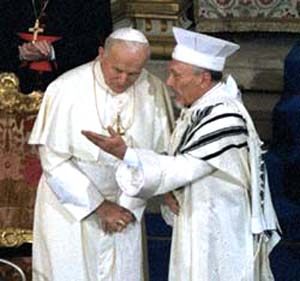
John Paul II with chief-rabbi Elio Toaff during his visit to the Rome synagogue - Internet photo
|
Benedict’s visit seems to have been included on his agenda from the time he was elected. The letter he wrote to retired chief-rabbi of Rome, Elio Toaff, as soon as he was named Pope certainly paved the way for that. On April 30, he wrote the chief-rabbi:
“With a heart grateful to God, I thank you, most distinguished Professor [Elio Toaff], for the good relations that you have woven with the Holy See, especially during the pontificate of my late predecessor, Pope John Paul II. I remember joyfully the embrace with which you welcomed him at the synagogue of Rome on April 13, 1986” (Vatican website).
It is significant that the last symbolic act of John Paul II’s pontificate was to receive 160 rabbis from all over the world at the Vatican last January, and that the first symbolic act of Benedict’s government was to greet the chief-rabbi of Rome. In January, JPII was “blessed” by the rabbis; in his turn, Benedict blessed Toaff at the start of his April 30 letter:
“United with you and the Jewish Community of Rome, I bless the Eternal One for his gift of the long and fruitful life that he has granted you” (ibid.).
What is becoming very clear in this love affair between the conciliar Popes and Judaism is that Progressivism is increasingly identifying itself with the Jewish religious goals, which are directly opposed to the bi-millenary position of the Catholic Church.
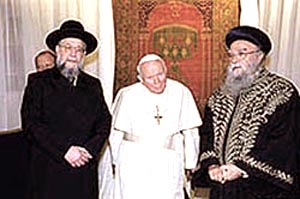
John Paul II wanted to meet the rabbis on his trip to Israel in 2000 - New York Jewish Times online
|
I report some symbolic actions of these conciliar Popes:
-
John XXIII abolished the final prayers of the Mass for the conversion of the Jews from their multi-secular perfidy.
- Paul VI identified himself so strongly with the Jewish religion that he wore the symbol of its high priest, the rational of judgment.
- Among innumerable symbolic initiatives to favor the Jews, John Paul II went to their synagogue in 1986, prayed at the Wailing Wall in 2000, was “blessed” by rabbis at the Vatican in 2005, and also named the rabbi of Rome in his last will and testament.
On the contrary, the Popes prior to Vatican II always condemned the Jewish religion as one of the most nefarious enemies of the Catholic Church. Let me report on the ones I found in my research:
- In his Epistula VIII, St. Gregory the Great (590-604) advised Catholics not to give Jews an absolute liberty because of the frequent offenses they made against the Faith. (1) In letters to the Frankish Kings Theodoric and Theobert and to Queen Brunehaut, he reminded them that Christians, members of the Body of Christ, should never be stepped on by Jews, enemies of Christ. (2)
- Honorius I (625-638) encouraged the 6th Council of Toledo (638) to act energetically regarding the danger the Jews represented for the Catholic Faith. (3)
- Leo VII (936-939) authorized the Archbishop of Moguncia, Germany, to expel the Jews from the city, given the constant attacks they launched against Catholics. (4)
- In letter of January 17, 1208 addressed to the Count of Nevers, France, Innocent III (1198-1216) lamented that the Jews were making use of usury to exploit Christians. (5)
- Gregory IX (1227-1241) wrote to the Western Bishops and Sovereigns ordering that all copies of the Jewish Talmud be apprehended. He charged William of Auvergne, Bishop of Paris, with organizing an investigation to verify whether or not the Talmud contained articles against the Catholic Faith. At its conclusion, the Talmud was condemned and copies of it were burned publicly in Paris in 1242. At the demand of the Jews, the Talmud was submitted to a new examination in 1248 and was definitively condemned by William of Auvergne along with the masters of theology of Paris, among them St. Albert the Great. (6) In the work Excerpta talmudica, written to justify this condemnation, one reads:
“By a secret design of Divine Providence, the errors, blasphemies, and outrages contained in the Talmud have escaped the eyes of the doctors of the Church until this day. The wall has finally been removed and one can clearly see the reptiles, the abominable idols that the House of Israel adores.”(7)
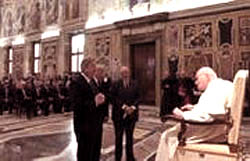
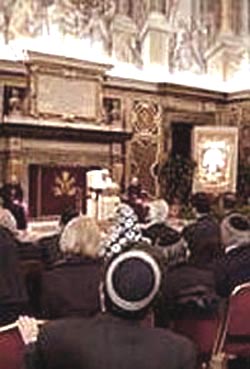
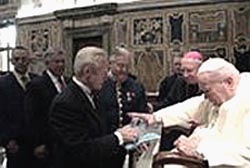
On January 16, 2005, John Paul II received 160 rabbis at the Vatican. On that occasion, three of them 'blessed' him in a ritual ceremony.Above are three close-ups of the event - L'Osservatore Romano online
|
- Innocent IV (1243-1254) ordered the Talmud to be burned because it was filled with errors and blasphemies. (8) In the Bull Sicut tua nobis of July 23, 1254, he authorized the Archbishop of Vienna to act with energy against the Jews for their constant blasphemies and actions against the Catholic Faith. (9)
- In the Bull Damnabili perfidia of July 15, 1267, Clement IV (1265-1268) also condemned the Talmud. (10)
- In the Bull Nimis in partibus anglicanis of November 8, 1285, Honorius IV (1285-1287) took the same action as his predecessors regarding the Talmud. (11)
- John XXII (1316-1334) also repudiated the errors of the Talmud with the Bull Dudum felicis recordationis of September 4, 1320. (12)
- In the Bull Dudum as nostrum of August 8, 1442, Eugene IV (1431-1447) forbade the Jews not only from living with Christians, as the Third Lateran Council had established in its Decreta (V, VI, 5), but also from living among Christians, given the continuous blasphemies and attacks of the Jews against the Catholic Faith. (13)
- Nicolas V (1447-1455), Calixtus III (1455-1458), and Paul IV (1464-1471) renewed the condemnations of their predecessors. (14)
- In the Bull Intenta semper salutis of May 31, 1484, Sixtus IV (1471-1484) commanded that the Jews in Spain should live separate from Christians to protect the latter from permanent danger to their Faith threatened by contact with Jews. (15)
- Leo X (1513-1521) known for his goodness toward the Jews, was nonetheless obliged several times to thwart Jewish blasphemies and abuses against the Catholic Faith. (16)
- Julius III (1550-1555) approved the Inquisition to seek out and burn the Talmud in 1553. In the Bull Cum sicut nuper, of May 29, 1554, the Pope ordered the Jews to hand over all their books that contained offenses against Our Lord Jesus Christ. (17)
- Paul IV (1555-1559) took severe measures in order to defend the integrity of the Faith and prevent the Jews from dominating Catholics. The Jews tried to bribe Paul IV by offering him 40,000 escudos to annul his Bull Cum nimis absurdum, which legislated against the Jews in the Pontifical States. (18) Along with other measures, the Pontiff ordered the destruction of the Talmud. (19)
- Pius IV (1560-1565) placed the Talmud on the Index librorum prohibitorum [Index of prohibited books] in 1564; he also prohibited its glossaries, interpretations and expositions. (20)
- In the Bull Hebraeorum gens of February 26, 1569, St. Pius V (1566-1572) condemned in particular the practice of “divination, sortilege, sorcery and witchcraft” among Jews. (21) In that bull St. Pius V also accused the Jews of the crimes of usury, robbery, receiving stolen objects, and the exploitation of prostitution. He ended the Bull with these words:
“Finally, we consider as known and proven how offensively this perverse generation [the Jews] uses the name of Christ, how hostile it is to those who carry the name of Christians, even making attempts against their lives.” (22)
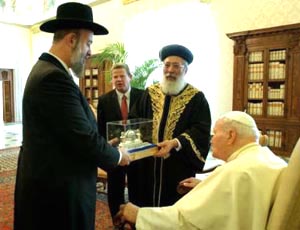
John Paul II being rewarded by the rabbis for his support of Judaism - NCR online, January 30, 2005
|
He expelled them from the Pontifical Territories since, in addition to the mentioned crimes, the Jews spied for the Muslims and supported their plans of conquest that endangered all Christendom. (23)
In the Brief of May 3, 1569, St. Pius V also affirmed: “We know that this most perverse people have been the seed-bag of almost all the heresies.” (24)
To this vigilant energy against the Jewish perfidy, St. Pius V added his zealous desire for their conversion. One of the most remarkable conversions he achieved was that of the chief-rabbi of Rome, Elias, followed by the conversions of his three sons and one grandson. On June 4, 1566, they solemnly received Baptism at the Vatican in the presence of the Sacred College of Cardinals. (25)
- In the Brief of May 27, 1581, Gregory XIII (1572-1585) warned the faithful and religious authorities against the false conversions of Jews as a means to infiltrate the Catholic Church. (26) In the Bull Antiqua judeorum improbitas of June 1, 1581, the Pontiff established these conditions for when Jews must be submitted to the vigilance of the Inquisition:
a. when they attack Catholic dogmas;
b. when they invoke devils or offer sacrifices to them;
c. when they teach Catholics to do the same;
d. when they speak blasphemies against Our Lord and Our Lady;
e. when they try to induce Catholics to abandon their Faith;
f. when they forbid a Jew or an infidel to convert;
g. when they consciously favor heretics;
h. when they disseminate heretical books;
i. when, in disdain for Our Lord, they crucify a lamb – principally on Good-Friday – and then spit on it and spew it with insults.
j. when they oblige Catholic wet-nurses to pour their milk into the toilettes and sewers after they have received the Eucharist. (27)
- In the Bull Cum hebraeorum of February 28, 1593, (28) Clement VIII (1592-1605) proscribed the Talmud, the books of the Kabala, as well as works written in Hebrew that contained errors. (29) The prohibition contained in this bull was included as a norm in the Index published on March 27, 1596. In the Bull Caeca et obdurate of January 25, 1593, this Pontiff also introduced new exhortations for the conversion of the Jews. (30)
- In the Brief of January 15, 1628 to the King of Spain, Urban VIII (1623-1644), dealt with the crime of usury practiced by the Jews in Portugal. (31)
- On September 15, 1751, Benedict XIV (1740-1758) signed and promulgated a document that reaffirmed the measures of caution regarding the Talmud taken by the Popes since Innocent IV. (32)
- In October 1775 and in January 1793, Pius VI (1775-1799) published two edicts confirming the directives of Benedict XIV regarding the Jews. (33)
- St. Pius X (1903-1914), through his Secretary of State, Cardinal Merry del Val, praised the classic work of Msgr. Henri Delassus, La conjuration antichrétienne [The Anti-Christian Conspiracy], which exposes the conspiracy of Judaism and Freemasonry against the Catholic Church and Christian Civilization. (34)
I offer these two lists of Popes – one of the four post-conciliar Popes favoring the Jews, and the other of the 25 previous Catholic Popes warning against them – to act as reference points for my reader. With them, he can assess what is happening in the Catholic Church regarding the Jews, and appraise where we are heading. These lists also provide good sources to evaluate the next visit of Benedict XVI to the synagogue of Cologne.
Footnotes:
1. Felix Vernet, Juifs et chrétiens, in Dictionnaire Apologétique de la Foi Catholique, vol. 2, col. 1726.
2. Epistula IX, CIX,CX; III, XXXVIII , apud ibid., col 1744.
3. René Aigrain, L’Espagne chrétienne, in Histoire de l’Église
depuis les origines jusqu’à nos jours, Paris: Bloud & Gay, 1946-1960, vol. 5, p. 246.
4 Auguste Dumas, Le sentiment religieux et ses aberrations, in ibid, vol. 7, p. 463.
5. Augustin Fliche, La réforme de l’Église, in ibid., vol. 10, p. 142.
6. Felix Vernet, Juifs et chrétiens, col. 1691; Christine Thouzeller, L’enseignement et les universités, in Histoire de l’Église, vol. 10, pp. 379-380.
7. F. Vernet, Juifs et chrétiens, ibid.
8. Registres d’Innocent IV, vol. 1, n. 682, Potthast, 11376, Chartularium, n. 131, vol. 1, nn. 173, 178; Saint Louis et Innocent IV, pp. 302-6, apud C. Thouzeller, L’enseignement et les universités, p. 380.
9. F. Vernet, Juifs et chrétiens, col. 1739.
10. Ibid., col. 1692.
11. Ibid.
12. Ibid.
13. F. Vernet, Juifs et chrétiens, col. 1740.
14. Ibid., col. 1728.
15. Bernardino Llorca, Bulario pontificio de la Inquisición española, Rome: Pontificia Università Gregoriana, 1949, pp. 106-108.
16. Brief of May 25, 1518 to the Nuncio in Venice, Arm. XL, vol. 3, n. 331, Pontifical Secret Archive, apud Ludovic Pastor, Historia de los Papas, vol. 8, p. 350.
17. Bull. VI, pp. 482-483, apud ibid, vol. 13, p. 208.
18. Masio, Cartas, 515, Berliner, 2, 2, 7, Rodocanachi, 40-41, in Révue des Études Juives, 20, 68; Cartas de San Inácio, V, pp. 288-289, apud ibid, vol. 14, p. 236.
19. Caracciolo, Vita, 4, 11; Erler, in Arquivo de Direito Canônico, L 3, 49; Reusch, 1, 48; H. Vogelstein - P. Rieger, 2, 156f.; Berliner, 2, 2, 8S.; see also same author, Censura y confisco de los libros judios en los Estados da la Iglesia (Frankfurt, 1891), apud ibid, vol. 15, p. 239.
20. F. Vernet, Juifs et chrétiens, col. 1693.
21. Bull. Rom. VII, p. 740, apud L. Pastor, Historia de los Papas, vol. 17, p. 301.
22. Apud F. Vernet, Juifs et chrétiens, col. 1712.
23. Brief of May 3, 1569, apud Laderchi, 1569, n. 187.
24. Apud L. Pastor, Historia de los Papas, vol. 17, p. 306.
25. Ibid., vol. 17, pp. 306-307.
26. Ibid., vol. 19, p. 281.
27. F. Vernet, Juifs et chrétiens, col. 1737.
28. Reusch, 1, 50, 333, 339, 534.
29. See the list of the books that he destroyed in Cremona, in Sisto de Siena, Bibliotheca sancta (Paris, 1610), pp. 310-311; F. Vernet, Juifs et chrétiens, col. 1738.
30. L. Pastor, Historia de los Papas, vol. XXIV, pp. 111-112; F. Vernet, Juifs et chrétiens, col. 1731.
31. Epistula V, Arquivo Secreto Pontifício, apud L. Pastor, Historia de los Papas, vol. 28, p. 285.
32. F. Vernet, Juifs et chrétiens, col. 1694.
33. Analecta juris pontificii, Rome, 1860, pp. 1422- 1423; apud F. Vernet, Juifs et chrétiens, ibid.
34. Henri Delassus, La conjuration antichrétienne, Lille: Desclée de Brouwer, 1910, vol. 1, p. V.

|